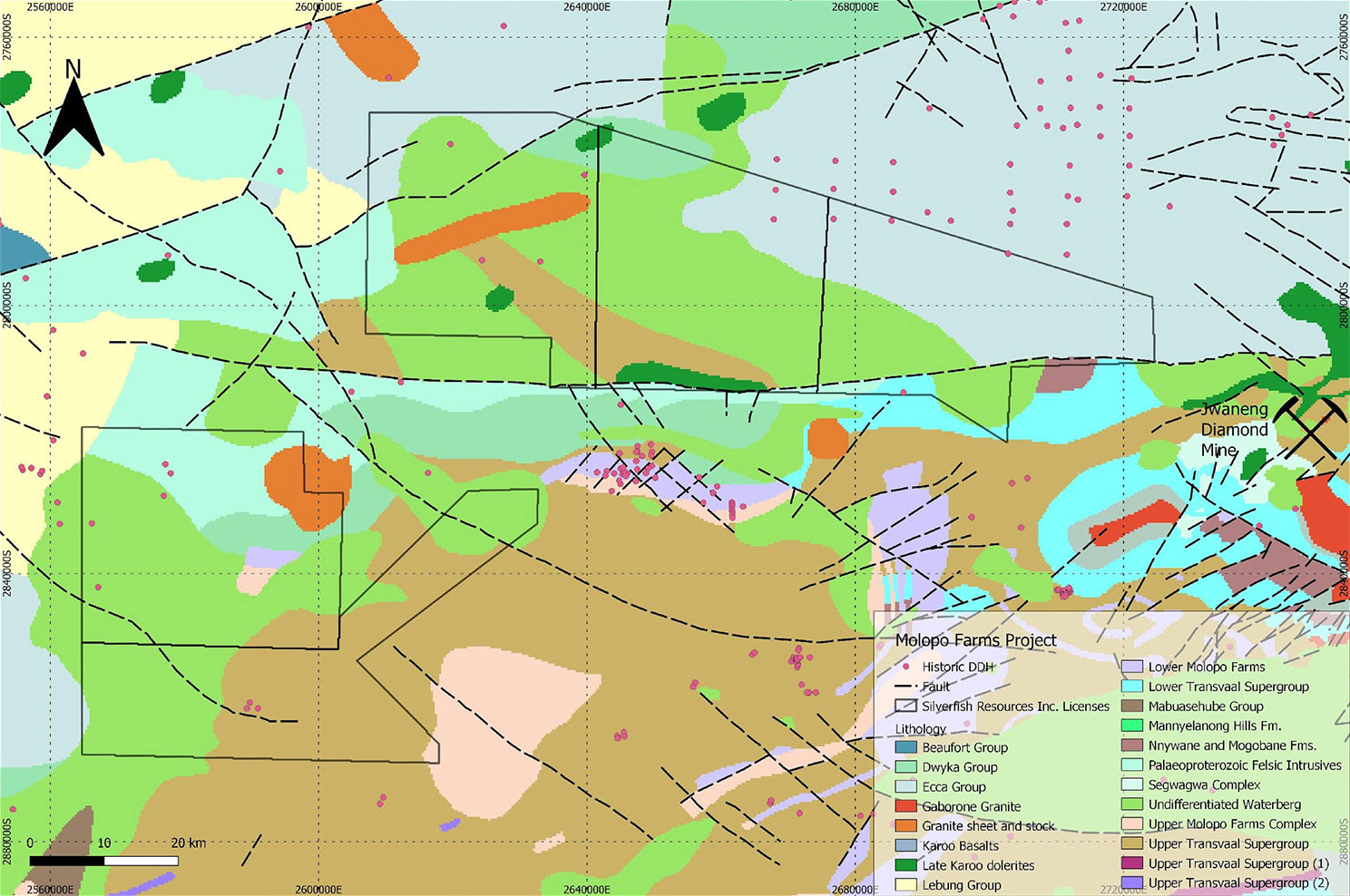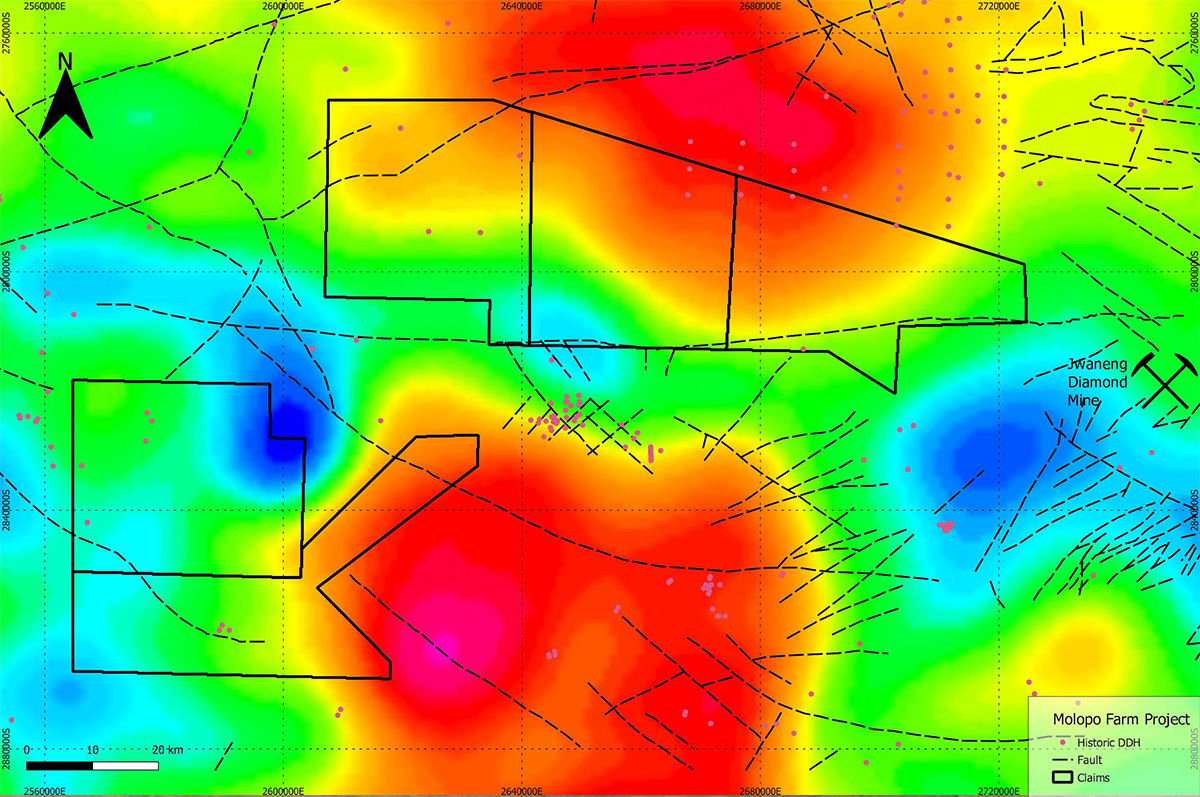Overview
The Aruba Project consists of five prospecting licenses totaling approximately 4,663 km2 in South-Central Botswana, approx. 200 km west of the coeval Bushveld Complex in neighboring South Africa. The project area is adjacent to Rio Tinto Exploration and is surrounded by good infrastructure.
Historic surface sampling within the project area has delivered:
- 3.25g/t PGM+Au,0.35%Cu & 0.60%Ni over 1.24m
- 1.8g/t PGM+Au with 1.73% Cr over 0.1m
- 14.6%Ni and 870ppm Co over 0.3m
MetalSource Mining has not verified the results of the historic exploration and sampling on the Aruba Project. Additional sampling would be required to verify the data.
Project Highlights
- Licenses contiguous to Rio Tinto
- Includes the basal units prospective for Nickel, Copper and PGE mineralization
- The western part of the project area is underlain by the highly prospective Transvaal Supergroup
- Located adjacent to South Africa, which accounts for 40% of world Manganese reserves
- The project can be operated year-round with no seasonal influences
- The geology of the area consists of Archaean and Proterozoic greenstone
- No surface water on any of the project areas meaning no disruption of local aquatic ecosystems
Kaapvaal Craton
Gold occurs in a variety of ancient geological environments, the most well-known being the unique Witwatersrand Basin in the central part of the Kaapvaal Craton. Outside of the Witwatersrand Basin significant quantities of gold have been recovered from Archaean greenstone belts of the Kaapvaal Craton as well as from various occurrences in the Transvaal Supergroup.

Transvaal Supergroup
The (Lower) Transvaal Supergroup, which includes the Kanye Basin of Botswana and the Transvaal and Griqualand West Basins of South Africa, hosts iron and manganese mineralization. Major deposits usually form close to the basin margin and are often less than 100 m above the basement. Deposit host rocks are typically sedimentary, including quartzite, siltstone, or shale.

Molopo Farms Complex
The Aruba Project covers a portion of the western margin of the 1,300 km2 Molopo Farms Complex (MFC) and is situated about 200 kilometers west of the coeval Bushveld Complex. Current thinking is that the MFC was emplaced by two sets of dykes forming two sub-lopoliths and sills.
The MFC consists of a well-layered lower ultramafic sequence and an upper mafic layer. It is structurally folded, block-faulted, and tilted into a southwest-plunging syncline and divided into northern and southern lobes. The area was later eroded and overlain by the Waterberg Group and Kalahari sands.
Exploration Targets
The Molopo Farms Complex is considered to be one of the most highly prospective areas for Ni-Cu and PGE. In most cases, PGE-enriched sulphide mineralization occurs near the contacts or margins of layered mafic to ultramafic units - MetalSource’s proposed drilling campaign is targeted at defining such contacts. Although the initial plan is to explore for a Ni-Cu-PGE magmatic deposit, there is a possibility for other mineralization styles (such as IOCG) and the existence of carbonatite in the area.
Due to Kalahari overburden, the MFC has only been inferred on MetalSource’s property by gravity and magnetic data from the area. Two Controlled-Source Audio-frequency Magnetotellurics (CSAMT) survey profile lines totaling 57,977km are proposed to establish the depth of the Kalahari cover in the project area. The CSAMT technique can detect conductive bodies at considerable depth - This will assist in explaining the sources of the magnetic high in the area while identifying deep lying conductors.
Work Programs
Phase 1
- Airborne geophysical surveys along Margins of the Malpo Formation
- Definition Geochemical surveys over targets
- Drill Testing of Conductors and Geochem anomalies
Phase 2
- Drill Testing of Conductors and Geochem anomalies
